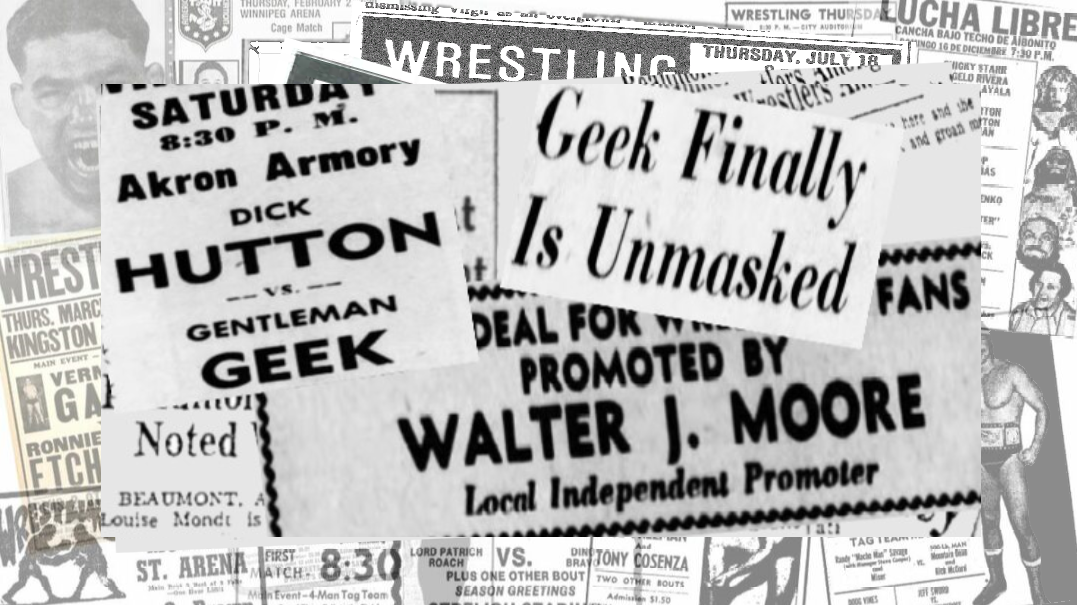On the evening of Saturday, December 11, 1954, in the dimly lit Akron Armory, an unknown figure emerged from the shadows, casting an awe-inspiring silhouette against the backdrop of the wrestling ring. The hooded figure stood at an impressive 6-foot-6, and his robust frame, weighing in at a formidable 250 pounds, exuded strength and power.
Labeled by the press as “the latest in a succession of masked men,” this was none other than the mysterious “Gentleman Geek.”
This is the story of the Gentleman Geek and his creator, longtime Akron promoter, Walter Moore.
Saturday, May 28, 1955 at the Akron Armory in Akron, Ohio
- Jim Hady & John Holley d. Danny Ferrazza and Steve Zold
- Don Arnold d. Jack Vansky
- Bobo Brazil d. Gentleman Geek (2-1, 19 minutes)
The history of professional wrestling is often told through the territories that formerly dotted the landscape of North America. But this history is incomplete, as it misses out on the stories of rank-and-file promoters who not only kept those territories alive by booking the talent on offer by the local territory but also helped create many of the unique, unforgettable characters that would inspire wrestlers, historians, and all the rest for the proceeding decades.
In the ever-changing whirlwind of Ohio wrestling, Walter Moore was a survivor. A local, blue-collar promoter, Moore had maintained a fiercely independent promotional sense, relying on the booking agents he believed could bring the very best to his Akron supporters.
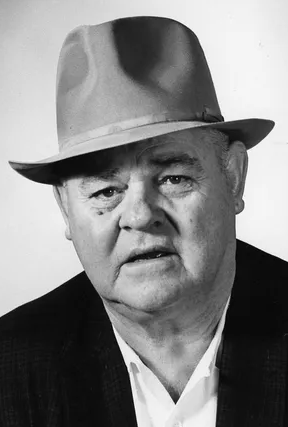
Walter Moore, Akron Beacon Journal
That sense of loyalty to his regular fans was hard-earned. The city had been effectively “dead” from a wrestling standpoint when the Akron grappler, truck driver, and loading dock worker decided to make a giant leap of faith and get into sports promotions.
With only modest funds to draw upon, the upstart Moore needed to find a winning formula — and fast. His first card, on December 28, 1941, was an unmitigated disaster, with the second only slightly better. That card, on January 8, 1942, nearly broke even, with Moore only taking a $200 loss for his efforts. His third card, however, was a success, and that success would continue unbated; his dedication and perseverance earning him loyalty from the fans for the next two decades.

Walter Moore’s “new deal” for Akron wrestling fans, 1942
For much of that time, Moore relied on talent from Al Haft, a one-time grappler turned premier promoter and booking agent in the Buckeye State. But Moore was an independent-minded promoter and sought to supplement his cards with unique stars that fans couldn’t see elsewhere, including talent from other nearby promoters, like Pedro Martinez, Toots Mondt, the Duseks, and Jack Pfefer.
And part of that independent mindset looked to reinvent existing talent to help build excitement for the regular crowds.
And that takes us to our card and a masked man who ran roughshod over Akron for the better part of early 1955.
The Geek’s first appearance was in the middle of the card on December 11, 1955, with the Geek quickly dispatching a young up-and-coming grappler by the name of Ray Stevens. Stevens was only two years into his storied career by late 1954 and was still a year and a half from his first title, but the quick work the Geek made — as well as his imposing stature — surely made an impression on the local fans.
It’s often said that newspaper archives are the “be-all and end-all” when it comes to studying classic wrestling, and it’s easy to understand why. Newspapers provide not only the build-up to events, but also the results, the competitors, and visual documentation of those events.
However, newspapers often fail to capture the backstory, the color, and the essence of pre-professional wrestling history. This is often because newspapers acted as a promotional middleman, serving as a conduit between the creative and the customer, resulting in a disconnect.
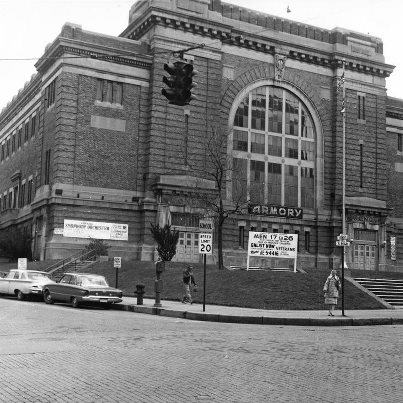
The Akron Armory
This disconnect is particularly evident in the case of The Gentleman Geek. There are no images of the Geek, no explanations of the name, no background information or color to speak of.
And it’s this glaring array of omissions that shows that papers are but one aspect of the wrestling story, with programs providing the missing links between a Gentleman Geek and his various rhymes and reasons.
Sadly, these programs are likely no longer extant — at least to my knowledge.
What is extant, however, are the reports of the Geek’s matches — and the path of destruction he left in his wake. The names that fell to the masked Gentleman Geek are impressive: The Great Scott (Dutch Schweigart), Joe Scarpello, Dick Hutton, Ray “Thunder” Stern, Big Bill Miller, and Primo Carnera, amongst others.
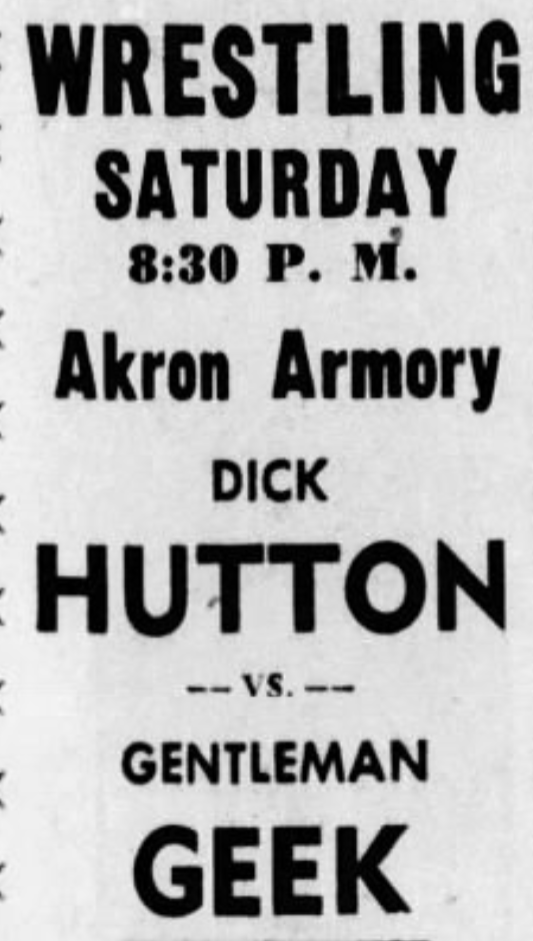
All told, some 15 men tried (and failed) to reveal the identity of the mask man. In fact, only one man — “Nature Boy” Buddy Rogers — would even defeat the Geek, although that loss was in a tag team affair on WAKR TV, meaning the masked Geek’s identity was safe.
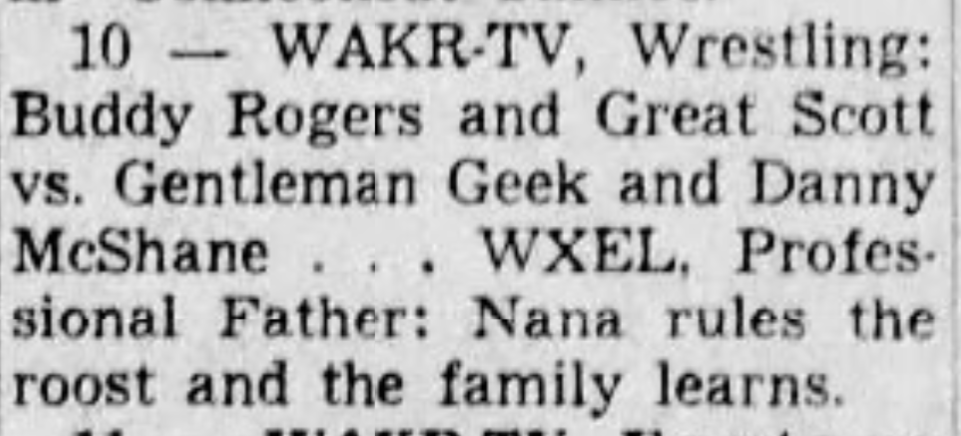
The Geek and Danny McShane vs. Buddy Rogers and The Great Scott
It seemed like the mystery would last forever.
But sooner or later the saga must end and the story told. And such was the case with the mysterious Gentleman Geek.
Eventually, the Geek’s luck ran dry. That day came on Saturday, May 28, 1955, when the Geek once again climbed into an Armory ring and found himself across the ring from a giant from Benton Harbor, Michigan.
Bobo Brazil, a hulking 6-foot-6, 270-pound mountain of a man was every bit as imposing as the Geek. He was quickly rising to prominence, having made a big splash on fans and across the nation thanks to a string of exciting bouts with the Great Bolo in Southern California earlier in the year, including ay Hollywood’s Legion Stadium.
Brazil had made his Akron debut just a week earlier, having topped Tommy O’Toole convincingly in the main event, with two falls in just 17 minutes. Coincidentally, O’Toole would go on to lose plenty of masks himself, as “Dr. X” and the creatively-title “Mask #1.”
For his part, the Geek dispatched Chief Big Heart, with the Pawhuska, Oklahoma, native unable to return for the third fall in another dominant victory.
The match was set — but it wasn’t much of a match.
But first, the undercard!
The opening bout is a bit of a mixed bag, with a pair of journeymen, an unknown, and a reality TV star. Both Jim Hady and Danny Ferrazza enjoyed lengthy, circuitous careers – by 1955, Hady was just starting out on a 15-year career while Ferrazza, a tattooed and mustachioed hero, was five years deep (about 1,000 territories).
Steve Zold was, by bell time, a 20-year ring vet and is most famous both today and on May 28, 1955 for his 1954 appearance on the CBS television program What’s My Line?, in which he won $35. And – you guessed it — John Holley is a big question mark.
The semi-windup provides a little more oomph, featuring Jack Vansky and the San Diego powerhouse Don Arnold. Dubbed the “Hercules of the West,” the beach bum Arnold was a fan favorite across the United States (though he would occasionally wrestle as the villainous “Dr. Death”).
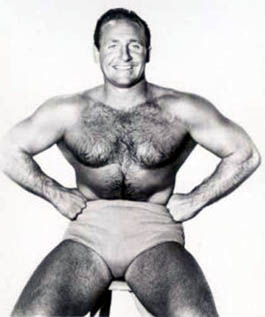
Don Arnold
In Vansky, Arnold faced a tough, grizzled 15-year ring veteran with the nickname “The Neck.” Vansky was no fan of pretty boys – as he laid bare to the Victoria Advocate in Victoria, Texas just eight months earlier:
I think that Victoria is lucky to have a wrestler of my capabilities on the card this Wednesday. I am one of the top men in my profession in the country, and I don’t believe that children, the likes of Ricki Starr, should even be on the same card as me… If the girls want to look at Starr this week, they had better come early as I intend to throw him out of the Sportatorium and Victoria.
Of course, just as in the case of his bout with Starr in 1954, Vansky lost.
Okay, on to the main event.
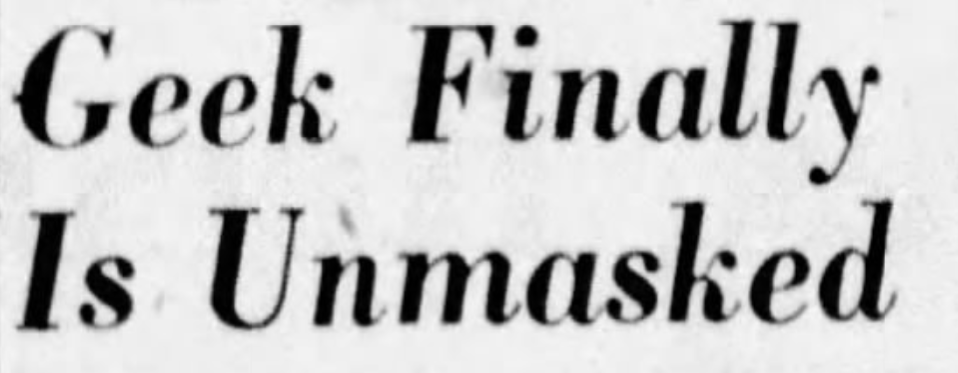
For a bruising baddie like the Geek, the defeat by Brazil was resounding — if not something of an upset — with the popular Brazil scoring two falls in quick succession (1:30 and 6:06) after the Geek scored the first fall in some 11 minutes.
Unmasked, the now red-faced former-Geek vowed revenge, with the rematch set for the next week.
So, who was the Gentleman Geek?
It was a bright eyed kid from New York, New York — Leonard Passaforo.
But you might know him better as Lenny Montana.
Montana was a five-year pro at this point, having begun his career bouncing around the Empire State and its various kingpins: Ed Don George, Toots Mondt, the Duseks, and Jack Pfefer. By 1954, he was an in-demand talent across the Midwest, under his “Lenny Montana” (sometimes stylized “Lennie”) alter ego as well as one of many to use the popular “Bull” Montana nickname, even appearing under that name while still masked as the evil “Geek.”
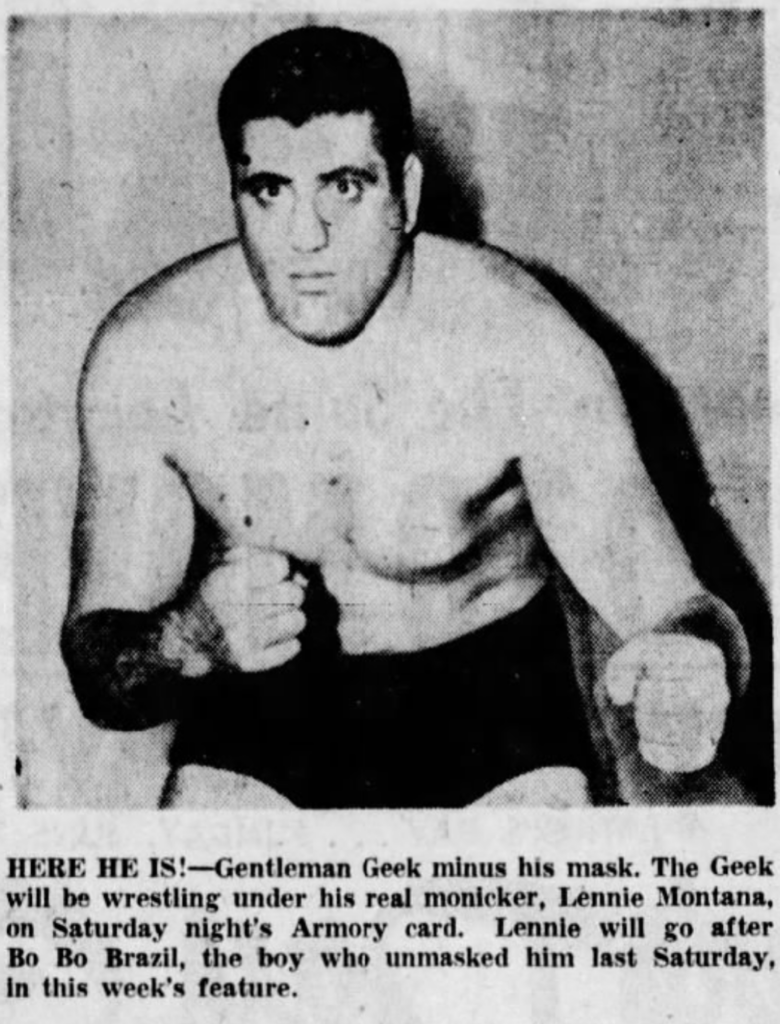
Montana was no stranger to the masked man gimmick. In fact, he had already been unmasked three times previously as an iteration of the famous Jack Pfefer creation, the “Zebra Kid,” by Rogers in 1951 and twice in the course of a month by the great Argentina Rocca in 1952.
And apparently being a heel came naturally to Montana — or, at least that’s what wrestling legend Buddy Colt had to say, as recounted in Greg Oliver’s retrospective on Montana’s defining role as Luca Brasi in The Godfather. “Lenny Montana was an asshole… Just his attitude, arrogant, about like somehow he felt he was over and above a lot of guys.”
But it was that look — or more correctly, that essence — that made the Geek so unlikeable. And it’s what made Brazil’s victory so triumphant for the fans of Akron.
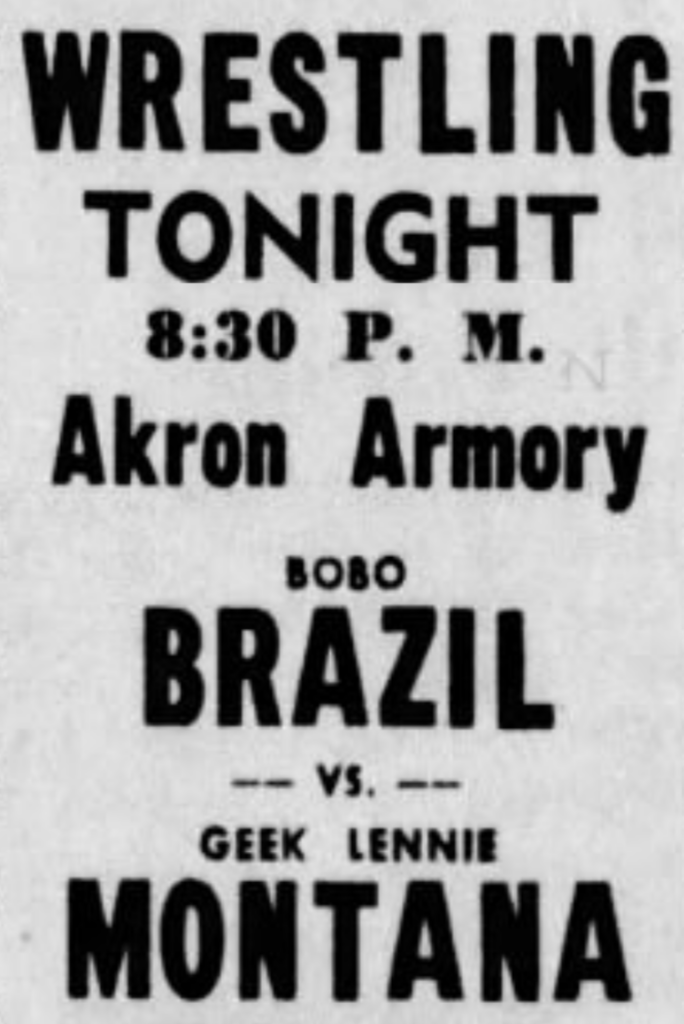
The Gentleman Geek was just a tweak — and one countless wrestlers would use to keep the action fresh in smaller territories and promotions across the country. And it’s these episodes — these glitches in the basic function of local wrestling — that make small promoters, like Walter Moore of Akron, so fascinating to study. He had grown his promotion from quite literally nothing, taking a huge gamble and ignoring consistent losses to make Akron one of the steadiest markets in Ohio wrestling for some two decades.
And it’s promoters like Moore, and oddballs like the Geek, that always keep me diving back into the archives for more — no matter what the limitations.
RELATED LINK
